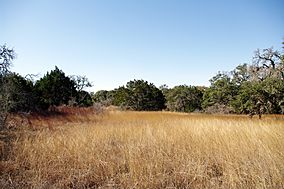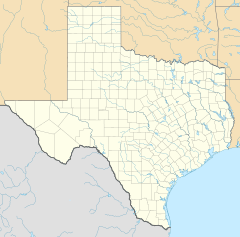Hill Country State Natural Area facts for kids
Quick facts for kids Hill Country State Natural Area |
|
|---|---|

Hill Country State Natural Area, December 2012
|
|
| Location | Bandera County / Medina County, Texas |
| Area | 5,369 acres (2,173 ha) |
| Established | 1984 |
| Governing body | Texas Parks and Wildlife Department |
The Hill Country State Natural Area (HCSNA) is a special place in Texas where nature is protected. It covers about 5,369 acres (that's over 8 square miles!) of beautiful, wild land in Bandera County. This area first opened to visitors in 1984.
Unlike a regular state park, HCSNA is called a "Natural Area." This means the main goal of the Texas Parks and Wildlife Department is to keep the land as natural as possible. Because of this, the facilities are simple, and some activities might be limited to protect the environment. It's a great spot to explore nature and see how wild Texas used to be!
Contents
Where is Hill Country State Natural Area?
The Hill Country State Natural Area is located right on the edge of Bandera County and Medina County. It's about 10 miles (16 km) southwest of a town called Bandera, Texas.
You can also find it about 20 miles (32 km) north of Hondo, Texas. If you're coming from San Antonio, Texas, it's about 45 miles (72 km) to the west-northwest. The address is 10600 Bandera Creek Road, Bandera, TX 78003.
Land and Rocks of the Area
This natural area is set among the pretty hills and canyons that are common in the Texas Hill Country. The land here sits about 10 miles north of a big step in the land called the Balcones Escarpment. It's also within a special area known as the Balcones Fault Zone.
The elevation, or how high the land is, ranges from about 1,280 feet (390 meters) to 2,000 feet (610 meters). A local fault line, called the Woodard Cave Fault, runs through the property. The land is made up of limestone hills and flat-topped hills called mesas. These are typical landforms you'd see in the Hill Country.
There are also flatter areas along the small creeks that flow through the property. The natural rock, called bedrock, can be seen in many parts of the preserve. The highest hilltops and the lower hills in the southern part of the area have a cap of strong limestone. This limestone is part of the Edwards Group, which is the main rock type of the Edwards Plateau to the north. The rest of the preserve sits on softer limestone.
Plants and Animals of HCSNA
The Natural Area is home to many different types of plants and animals. It has eight main plant communities and over 450 different kinds of plants!
Most of the preserve is covered by woodlands of Texas live oak and Ashe juniper, sometimes called "mountain cedar." You'll also find live oak savannah (grassy areas with scattered trees) and Texas red oak woodlands. Open grasslands are common too, with plants like sideoats grama and little bluestem.
Smaller plant areas include Lacey oak trees, pecan and sugarberry groves, and other types of grasslands. You might also see fields of sotol plants. Sadly, some of the natural plants have been affected by too much grazing by animals and by new plants that aren't native to the area.
Birds to Spot
HCSNA is a fantastic place for bird watching! More than 160 different kinds of birds have been seen here. This includes two very special birds that are considered endangered: the golden-cheeked warbler and the black-capped vireo. These birds need extra protection to survive.
Mammals You Might See
The most common large mammal you'll find here is the white-tailed deer. You might also spot wild turkeys, armadillos, skunks, raccoons, opossums, and different kinds of rabbits and squirrels.
Sometimes, you might see wild pigs, or exotic deer like fallow and axis deer. Porcupines and ringtailed cats can also be found. While bobcats, coyotes, and foxes live in the area, they are usually shy and hard for visitors to spot. Mountain lions are very rare but do live here too.
History of the Land
People have lived on this land for thousands of years. Many Native American artifacts, like tools and other items, have been found here. Even human remains have been discovered.
When European settlers arrived in the mid-1800s, the area became a working ranch. The flatter parts were used for growing crops, and the rest was for grazing animals. This land eventually became known as the Bar-O Ranch.
Between 1976 and 1982, a woman named Louise Merrick generously donated several parts of the land. Her wish was for the property "to be kept far removed and untouched by modern civilization, where everything is preserved intact, yet put to a useful purpose." This is how the Hill Country State Natural Area was created.
The preserve first opened to the public in 1984 with about 4,753 acres. In 1986, more land was added, bringing the total size to its current 5,369 acres.
Fun Things to Do at HCSNA
HCSNA has over 40 miles (64 km) of trails that you can use for many activities! You can go hiking, biking, or even horseback riding. If you have horses, there are special facilities for them. You can find more details on the official Texas Parks and Wildlife Department website.
Some dude ranches are located next to the natural area. They often lead groups on hikes and trail rides through the preserve. The West Verde Creek flows through the area, and when the water levels are high enough, you can go swimming or fishing.
To help manage the deer population, the park allows a limited number of hunters during a few weekends each season. HCSNA also hosts a big running event every January called the Bandera 100 km ultramarathon.
Leave No Trace Principles
HCSNA wants all visitors to follow the "Leave No Trace" rules. These are important ideas to help protect the wilderness:
- 1) Plan Ahead and Prepare: Know what to expect and be ready.
- 2) Travel on Marked Trails Only: Stay on the paths to protect plants and animals.
- 3) Always Dispose of Waste Properly: Pack out everything you pack in.
- 4) Leave Behind What You Find: Don't take rocks, plants, or artifacts.
- 5) Never Build An Open Fire: Fires can be dangerous in natural areas.
- 6) Respect Wildlife: Watch animals from a distance and don't disturb them.
- 7) Be Considerate of Other Visitors: Share the trails and be polite.
Camping at HCSNA
Since HCSNA is a "natural area," it's kept mostly wild and undeveloped, unlike a typical state park. Camping options are simple. There are nine walk-in campsites, which means you park and then walk a short distance to your spot. There are also three small hike-in camping areas, which are further away.
For those with horses, there are five equestrian campsites that include pens for your horses. These campsites do not have hookups for sewer, electricity, or drinking water. There is one group lodge with electricity, but it also doesn't have drinking water hookups.
Nearby Parks to Explore
If you enjoy visiting natural areas, here are some other great parks nearby:
- Garner State Park
- Lost Maples State Natural Area
- Government Canyon State Natural Area
- Guadalupe River State Park and the nearby Honey Creek State Natural Area


